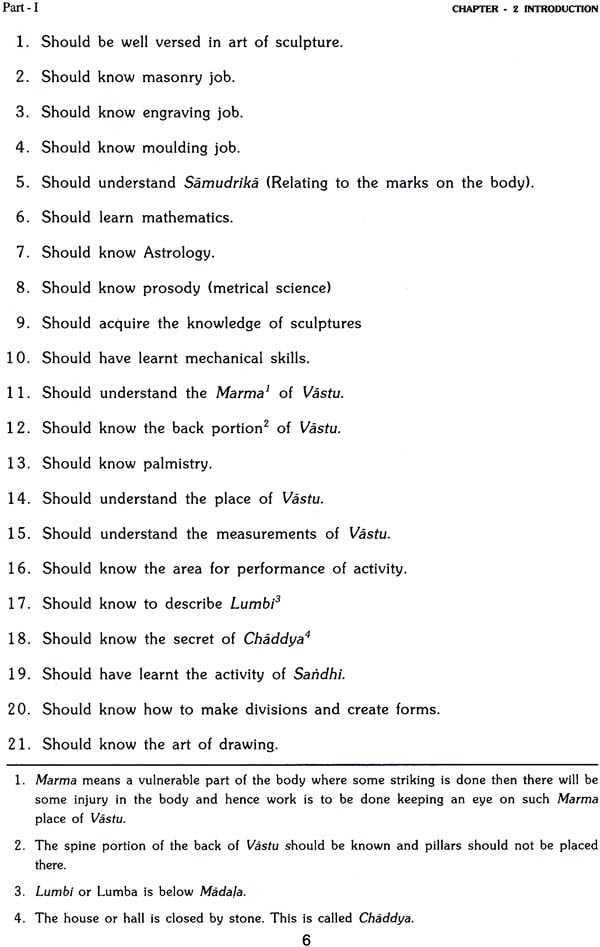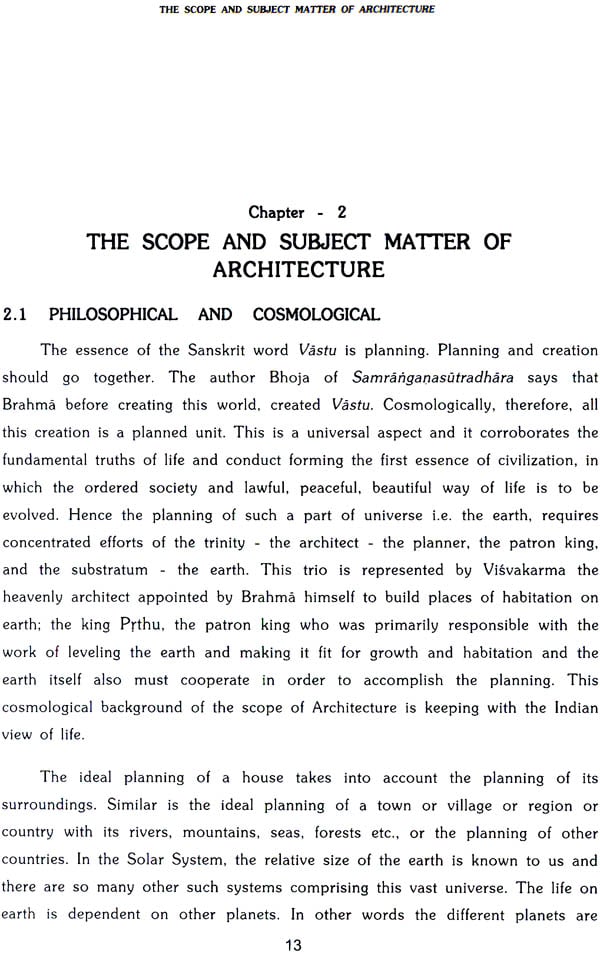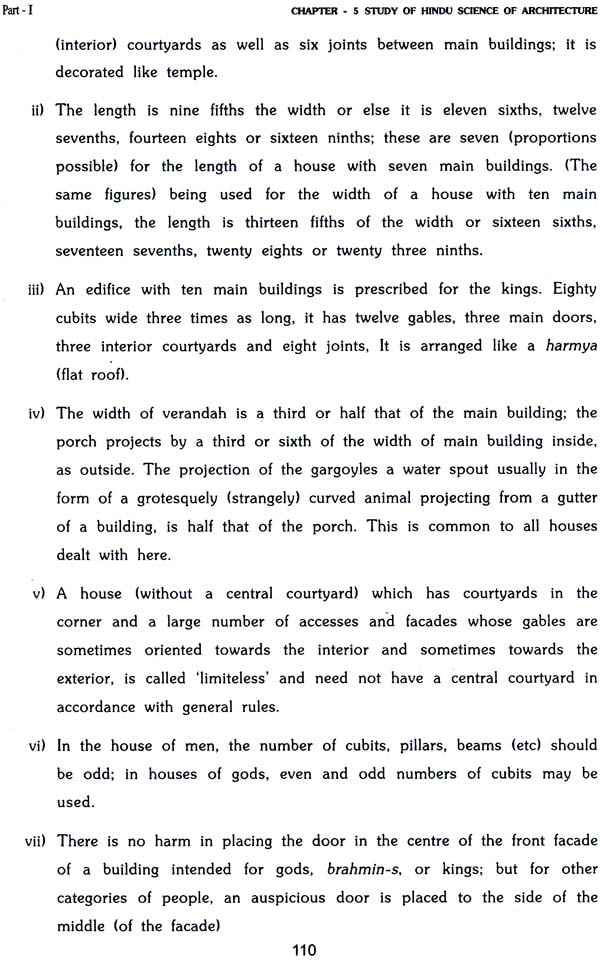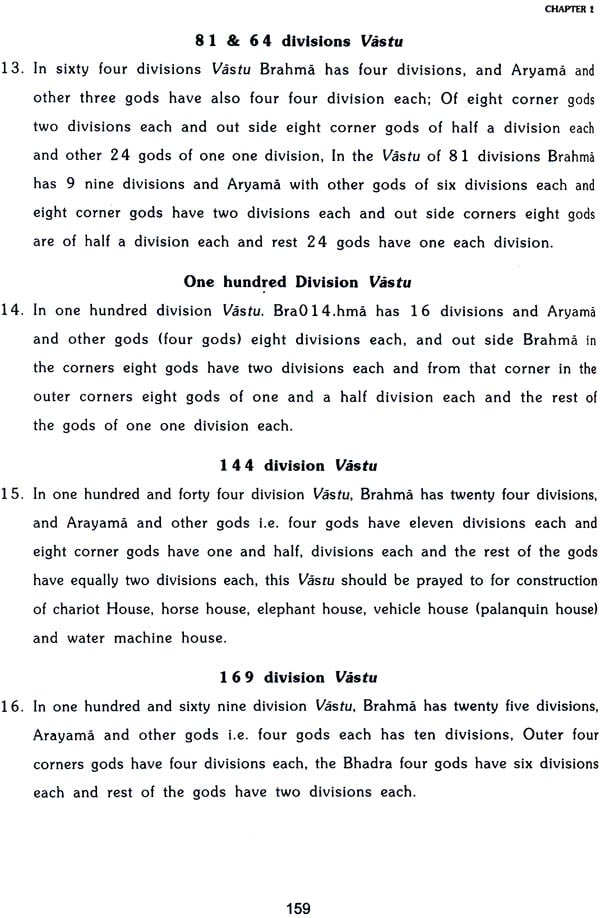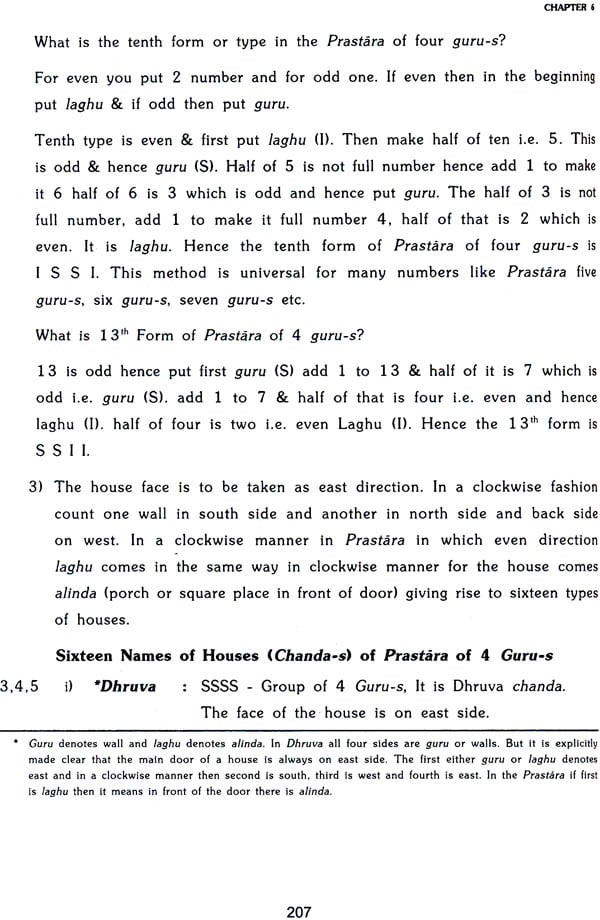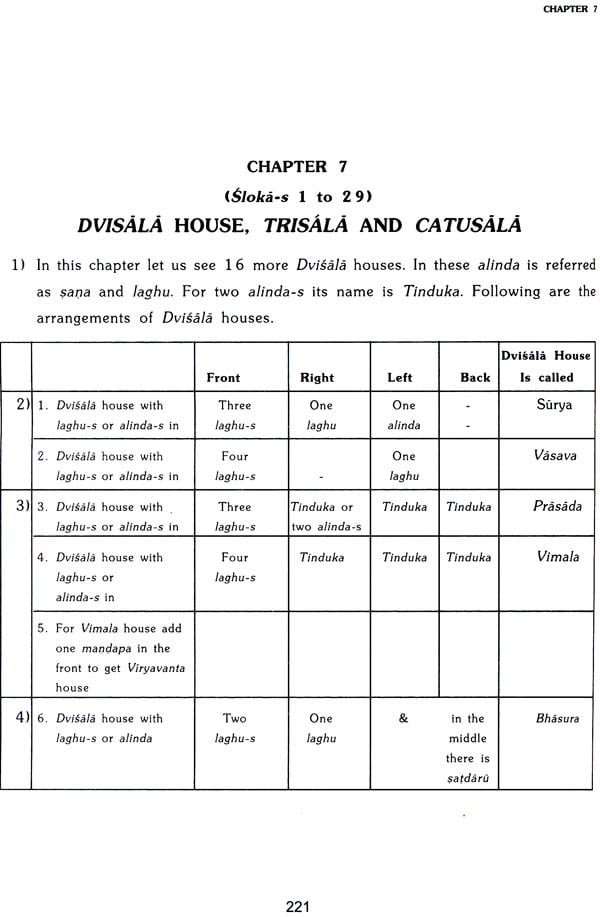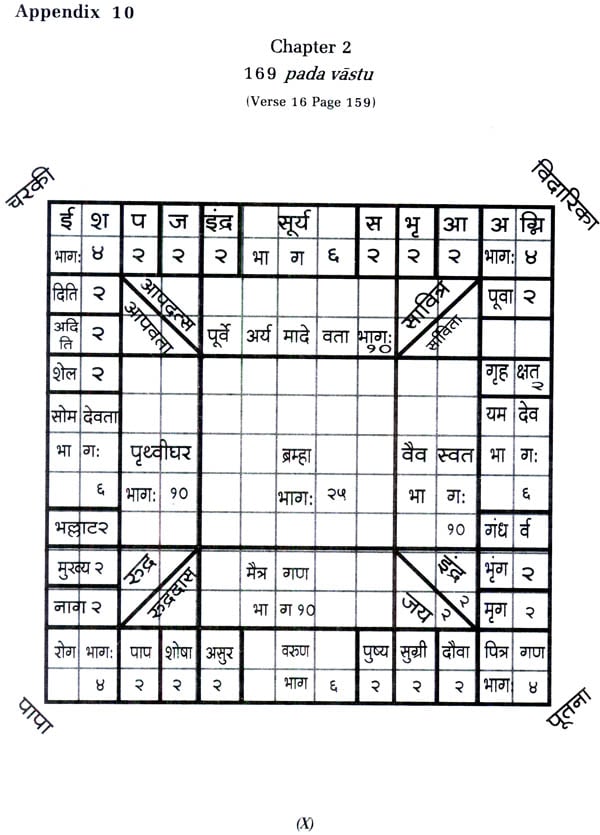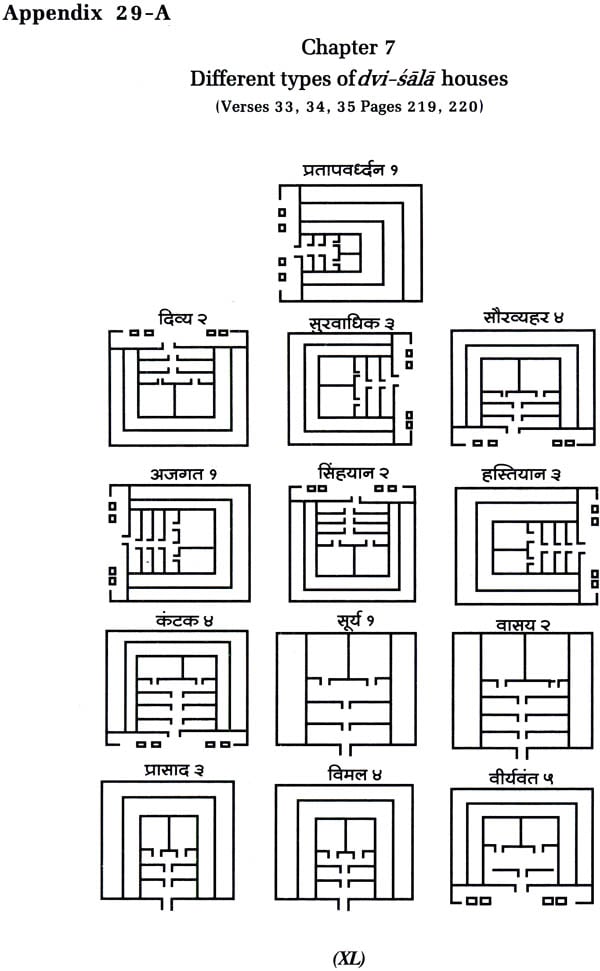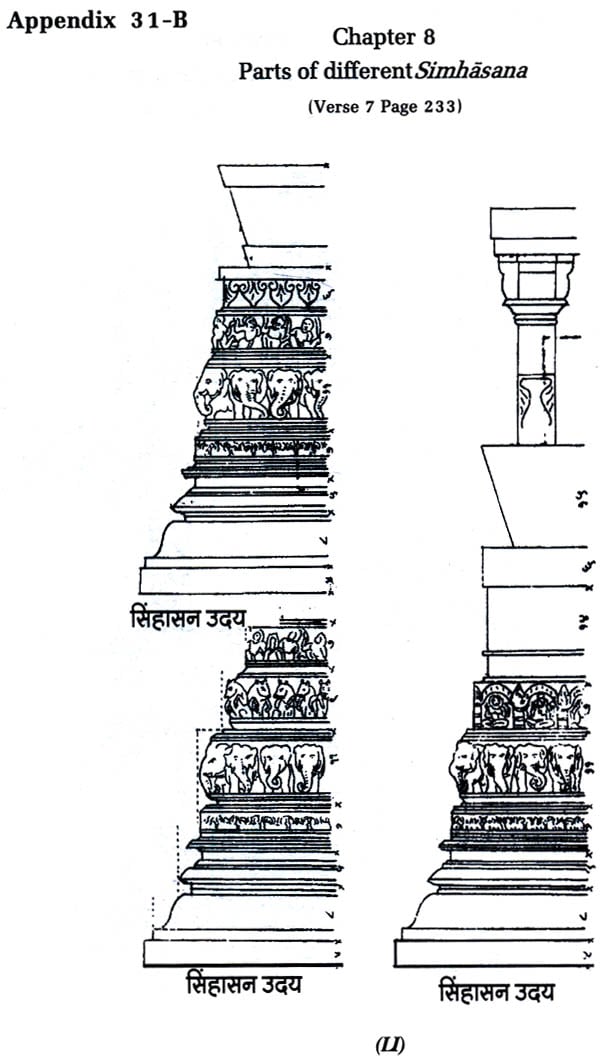
A Study of The Hindu Science of Architecture and its Practice with Special Reference to Rajavallabha
Book Specification
| Item Code: | NAD103 |
| Author: | Dr N.R.Dave |
| Publisher: | Bharatiya Vidya Bhavan |
| Edition: | 2011 |
| ISBN: | 9788172764517 |
| Pages: | 404 |
| Cover: | Paperback |
| Other Details | 9.5 inch X6.5 inch |
| Weight | 510 gm |
Book Description
Dr.Nandakumar R.Dave
Dr.N.R.Dave is a Civil Engineering Graduate from I.I.T Madras. He passed B.Tech in 1965 after working in Government and Private Companies in 1967 he got himself self-employed as consulting Engineer and Builder. Since last 43 years he has to his credit construction of many prestigious Residential, commercial, Community and Industrial Buildings. He has developed expertise in construction of multistoried complexes in continuous area building zones of Chennai city. The repairs and alterations of buildings is another area where he has developed expertise. He has written papers on ‘Social Aspects of Civil Engineering’, ‘Cracks and repairs in Buildings’, Maintenances of Buildings’, etc. He is a member of Concrete Association of India, Valuers Association, Vastu Sastra Circle, and Fellow of Institution of Engineers & Fellow of institution of valuers.
In social and public field he was Under Sheriff, Madras in 1994. He was Diamond Jubilee District Governor of Lions Clubs International, District 324 a1 in 1991-92. He is the author and Managing Trustee of Lions Hearing Aid Bank, Dist.324a1 lions Eye Bank Trust & Foundation. He is the founder Trustee of lion’s edifice for service Trust, Heart Foundation and Lions Foundation for the Blind. He has been chiefly responsible in the creation of ‘Lions Cornea Block’ which is now the standing monument of service in the premises of ophthalmic hospital. The lions Model Eye Bank of which he is the author is a standing monument of service to the Sightless at Govt. Ophthalmic Hospital. Doordarshan has interviewed him on his social Activities.
He is life Member of Institution of Engineers (India). He is the Committee Member since last 31 years and at present he is the President of 90 years old Sri Z.P.H. Gujarati Kanya Kelavani Mandal. He is President of The Hindu Theological Higher Secondary School which is 120 years old. He is Vice President of “HINDUSTHAN CHAMBER OF COMMERCE”
He has been awarded “Distinguished Alumnus Award” by I.I.T. Madras in 1996. In 2008 Sri Gujarati Mandal Awarede him “Chennai Gurjar Ratna Award”. Jagatguru Sankaracharya of Kanchikamakoti Peetam Pujya Sri Jayendra saraswati swamiji conferred ‘JANA SEVA’ title on him on 12th June 2010. He has been awarded “Paul Harris Fellow” awarded by Ratary International to honour his services in the field of Eye Donation. He is pursuing his studies in Sanskrit. In 2002 he passed M.A Sanskrit. From 2005 to 2009, he carried out research at University of Madras through Sanskrit Department and Presented Thesis on “The Hindu Science of Architecture, and its Practices with special Reference to Raja Vallabha”. He has been awarded doctorate of Philosophy (Ph.D) in May 2010 by University of Madras.
It is a matter of great pride that the book. ‘The Hindu Science of Architecture and its practices with special reference to Rãjavallabha’ is getting printed and published. Dr. N.R. Dave, a well known Chartered Engineer and Social worker from Chennai desired me to write foreword to his wonderful book. It is commendable that Dr. N.R. Dave as a professional decided to make an indepth study of Hindu Science of Architecture and brought out the basic scientific principles and methodologies adopted in the construction of ancient Temples, Palaces, Buildings and other Civil Structures. For modern Students of Civil Engineering and Architecture this book will be a boon as it explains the five fundamental canons of Hindu Architecture dearly and vividly.
Earlier it was thought that Vãstu is to be followed only for the construction of temples and palaces and not for buildings. But in the last fifteen years, Vãstu has become popular. Nowadays it is advertised by builders in the News papers that flats and buildings are constructed as per vastu. Does it mean that Vastu is only a placement of rooms in particular directions? No; it is not so. On the other hand Vastu has wider implications. Any planning and construction of a structure is Vastu, like Town Planning, buildings, Temples, Royal and Dwellings) markets, roads, gardens, lakes, wells, fountains, compound walls and other constructions. It also includes weapons, dresses and embroidery, Jeweilary, furniture, sculpture, painting etc. The principles of orientation and Planning, measurements, proportions and mathematical formulae, types of buildings and perspectives, materials, principles of astronomy, auspicious time, etc. are explained in great detail with illustrations in the Rajavallabha a work of great importance from Gujarat, written by a Acarya Mondana.
Contrary to common belief that Vstu cannot be followed in modern buildings and flats, nowadays the planners and builders are accommodating some principles of Vastu in buildings. The placement of columns and walls are avoided on the ‘Vedb.a’ points. They are so oriented as to get the benefit of maxinnun air, light and positive flow of energy. The proportions of height, length and width are also designed appropriately.
In the design of modern siopping malls, the centre place is kept open. This is the rhaaa of V4stu, which is reqiire4 to be kept open The concept of green building has tiLe principle of flqyg ztu 1ig4 i. tke The long spanned structures like Malls and Airports have colunms placed at large distance. They re designed keeping in mind structural stability and use of suitable building materials. The open cantilever foyers are leveraged by built up area in the main building.
Not only one should build beautiful building but also build beautiful Life in the building. The body is made of the same Pancabhuta.-s (five elements) as that of the Universe. If there is synchronization of house and living body with the universe then it will result in beautiful life, wherein there is peace, prosperity and happiness. The principles of Vastu enables one to build beautiful lie.
Dr. N.R. DAVE has divided his work in to two parts. The first part introduces the Hindu Science of Architecture, its history, its scope and subject matter and qualities of an architect. The study of five fine scriptures of Vastu-.4ãstra-s namely Sa.marangana Sütradhãra, Aparajita Pacchã, Manusyalaya Candrika, Mayamata and Rajavaflabha, on different aspects of Vastu-.astra is praiseworthy. The five canons of Hindu Architecture are explained in detail to enable the reader to learn how the planning, proportions, measurements, various mathematical formulae, testing of soils, placement of trees round the building, and perspectives of- structures are based on scientific principles. The second part is a free translation of RJjavallabha. From Sanskrit Gujarati to English. Rajavallabha is a complete Vastu scripture and Dr.N.R. Dave has translated it into English with great care perhaps for the first time to see that it conveys the same meaning of Acãrya Mandana who has written the original Sanskrit text. Explanations in the form of footnotes are provided for clear understanding of specific names and terminologies.
The speciality of Rajavallabha is that in the chapter of housings all types of housings like Ek-salã, Dwi-sãia, Tri-sala, Catu-salã etc. are described in details with figures and each type of house with various permutations and combinations are described with specific names in Sanskrit. The chapter on Astronomy, fixing auspicious time for various ceremonies, Astrology describing horoscopes for buildings and a full chapter on Omens makes very interesting and educative reading of this beautiful scripture.
Dr. Kanaiyalal M. Munshi, the founder of Bharatiya Vidya Bhavan had made it a mission of his life for studies and development of Bharat’s heritage and cultural values. I am extremely happy that Bharatiya Vidya Bhavan has come forward to print and publish this great work of learned author Dr. N. R. Dave. Through research and case studies let Dr. N.R.Dave, the social worker help people to live trouble free, tension free and prosperous lives.
“A Study of Hindu Science of Architecture and its practice with special reference to Rãjavallabha” is an attempt to share with non Sanskrit knowing readers the contents of the text. As a practising Civil Engineer for more than forty years, I have designed, constructed and repaired many residential, commercial and industrial buildings, using reinforced concrete and modern building technology. In repairing many old buildings, I came across ‘Madras Terrace’ roofing wherein the wooden rafters and wooden beams were used. Wooden Pillars were also used for supporting the beams. In many places brick masonary was used in mud and lime mortars. Plastering was done with lime mortar. In the design of old residential buildings, the central raised ceilings called Kalyana-kudams were provided to keep Ventilation. A big residential building consisted of multiple Kalyana-kudam-s. The buildings were constructed on square or rectangular plots and faced the cardinel directions. Each living portion was built to face a particular direction. I was given to understand that building structure was planned as per Vãstu in olden times. In early professional career, my goal was to be a successful Planner, Engineer and Builder and hence I did not have much time to learn about Vãstu principles. But, of late, since the beginning of the twenty-first century, a new interest has been kindled among owners andbuilders to construct buildings as per Vãstu and correct Vastu-dosa in existing buildings. With more time for learning, I decided to start study on Ancient Hindu Architecture. But I found that the ancient Vãstu literatures were in Sanskrit and though English commentaries were available on some of these books a working knowledge of Sanskrit language was a must. With basic knowledge of Sanskrit, I decided to appear for M.A. (Sanskrit) examination and passed the same in 2002 from KSOU. After a couple of years, in one of the meetings in the University of Madras, Marina Campus, I met the Head of the Department of Sanskrit Dr. Siniruddha Dash and showed my interest to study Västu. He invited me to the Department and encouraged me to join the University for Ph.D. course under the guidance of Prof. Dr. S. Padmanabhan. I enrolled myself for Ph.D and as per the guidance of Prof. Dr. S. Padmanabhan, made preliminary studies of - Samaranganasutradhara (S.S.) by Dr. Shukla, Aparajitaprccha (A.P.) by Prof. Mankad and Rajavallabha (R.V.) by Sri Manclana which was published by M/s.Uday Jagushte with Gujarati translation by Sri Narayana Bharati Yashwantabhãrati. The first two books gave me a lot of insight in the principles of Ancient Indian Architecture. I found Rajavallabha as a complete book on Vãstu and i1pa-astra, with detailed study of Astronomy, Astrology and Omens. I found details of varieties of residential houses with various permutations and combinations and each with specific name for type of house. As a Civil Engineer, I found this book very interesting. And as a Gujarãti born and brought up in Chennai, I thought it would be easy for me to translate Rãjavallabha into English so that all sections of people will have access to this comprehensive and educative book on .i1pa-ãstra. Care is taken to illustrate with charts, figures and drawings wherever necessary. I dedicate this thesis to my parents who trained me from childhood in Hindu culture and to the people of Tamil Nadu and Gujarat who have spread this ancient science in their own states and other parts of the country.
I hope this book will be of immense use to architects and civil engineers in planning and designing of buildings and others structures.
I am beholden to Dr.S. Padmanabhan, Professor of Sanskrit, University of Madras for his guidence and advise in bringing out this book. My thanks are to Dr. R. Ananthan, former Professor of Vivekananda College, Chennai for editing the book. My gratitude to Dr. Udayan I-I. Shukla, Senate Member of M.S. University of Baroda for agreeing to write the foreword to this book.
For the purpose of illustrations, the charts the drawings and the figures have been used from Rajavallabha (Gujarati) published by M/s.Uday Jaguste, Ahmedabad. My sincere thanks to this publisher.
I am beholden to Bhartiya Vidhya Bhavan and especially Mr. K.N. Ramasamy, Director for printing and publishing this book.
Chapter Title
| Chapter | Page No |
| Prayer to Vlsvakarma | xii |
| List of abbreviations | xiii |
| Foreword | xiv |
| Preface | 1 |
| Chapter 1: 1.1 Introduction | 3 |
| 1.2 The method of treatment | 11 |
| 1.3. Method of Study | 12 |
| Chapter 2 :The Scope and subject matter of Architecture | 13 |
| 2.1 Philosophical and Cosmological | 13 |
| 2.2 Meta – Physical | 14 |
| 2.3 Astronomical – Astrological | 14 |
| 2.4 Geographical – Geological | 14 |
| 2.5 Architectural: Building Materials, Construction | 15 |
| chapter 3: The Architect and Architecture | 17 |
| 3.1 The Sthapati and his Equipment and Qualifications | 17 |
| 3.2 The Knowledge of The Science- Vastu sastra | 18 |
| 3.3 Practical Experience of Karma | 18 |
| 3.4 The Personal Insight, Prajna | 19 |
| 3.5 The Character, Si1a | 19 |
| 3.6 Sthapatya & Eight Fold Limbs | 19 |
| Chapter 4 An outline of Hindu Architecture both as Science and Art | 21 |
| 4.1 Origin of Indian Architecture | 21 |
| 4.2 Rise of The ãstra And the place Of VIvakarma | 23 |
| 4.3 Maya | 24 |
| 4.4 Vãstu literature | 25 |
| 4.5 Ancient Vastu literature and its classifications | 26 |
| 4.5.1 Vedic Literature | 27 |
| 4.5.2 Epics | 30 |
| 4.5.3 Buddhist literature | 30 |
| 4.5.4 Kautilya’s Arthagastra | 31 |
| 4.5.5 Purãna-s | 31 |
| 4.5.6 Agarna-s | 32 |
| 4.5.7 Tan tra-s | 33 |
| 4.5.8 Brhatsamhita | 33 |
| 4.5.9 Miscellaneous & .iIpa works | 33 |
| Chapter 5 .Study of Hindu science of Architecture | 35 |
| 5.1 Samarangava - sutradhâra - The scope and outline history of Hindu Architecture | 35 |
| 5.1.1 The Advent of Earth | 36 |
| 5.1.2 The Dialogue between Father & Sons | 36 |
| 5.1.3 The Query | 37 |
| 5.1.4 The Geography | 37 |
| 5.1.5 The mortals in the company of the Immortals and the rise of houses in the model of a tree | 38 |
| 5.1.6 The division of Society according to Varna and A.4rama-s | 38 |
| 5.1.7 The Qualifications of an Architect | 38 |
| 5.1.8 The Eightfold limbs of the body of Västutastra | 39 |
| 5.2 A study of AparãjItaprcch (A.P.) edited by Professor P.A. Mankad | 39 |
| 5.2.1 Vastudevatã Padavinyasa | 40 |
| 5.2.2 Theory of Orientation | 42 |
| 5.2.3 Styles of Indian Architecture | 44 |
| 5.2.4 Styles of Architecture in Samarãilgana sOtradhâra (S.S) | 45 |
| 5.2.5 Styles in Aparjitaprccha | 46 |
| 5.2.6.1 Vesara in Vasturaja | 47 |
| 5.2.6.3 Vesara in Epigraph | 48 |
| 5.2.7 Differentlatirg Characteristics of Nagara, Vesara & Dravida styles of architecture in A.P. | 49 |
| 5.2.8 Plava | 59 |
| 5.3 HousIng In ManuydIaya Candrlkd | 60 |
| 5.3.1 The various steps of house making | 60 |
| 5.3.2 Examination of Soil | 63 |
| 5.3.3 Good and bad omens for ceremony of house building. | 66 |
| 5.3.4 VastuvlnyasaWdhi or Planning | 67 |
| 5.3.5 Three types of Vastuvinyasa | 71 |
| 5.3.6 Vithivinyasa | 72 |
| 5.3.7 FIxing of the area of building construction | 73 |
| 5.4. Study of Mayamata with reference to housing and Its features | 79 |
| 5.4.1 Features of houses for four classes and specific arrangements for houses of each class | 79 |
| 5.4.1.1 The wall of the enclosure | 79 |
| 5.4.1.2 Annexes | 80 |
| 5.4.1.3 Houses with main buildings separated or in blocks | 81 |
| 5.4.1.4 Layout | 81 |
| 5.4.1.5 Dimensions of Central pavilion | 81 |
| 5.4.1.6 Position of annagãra etc., | 82 |
| 5.4.1.7 Elements of the upper part of the house | 84 |
| 5.4.1.8 Proportions for dwelling pavilions | 84 |
| 5.4.1.9 Position of foundation deposit | 85 |
| 5.4.1.10 The Muhurtastambha | 85 |
| 5.4.1.11 General rules | 86 |
| 5.4.1.12 The verandah | 87 |
| 5.4. 1. 13 The chamber of the master | 87 |
| 5.4.1.14 Covering of the main buildings | 87 |
| 5.4.1.15 Distribution of appurtenances: (a thing added to the main building) | 88 |
| 5.4. 1.16 The four types of dwelling | 89 |
| 5.4.1.17 Door proportions | 91 |
| 5.4.1.18 Time for construction | 91 |
| 5.4.1.19 Door positions Apartment positions | 91 |
| 5.4.1.20 Aparment Positions | 92 |
| 5.4.1.2 1 Period of beginning of construction | 92 |
| 5.4.2 Housing in Mayamata | 92 |
| 5.4.2.1 Types of Houses | 92 |
| 5.4.2.2 Dimensions of main Buildings | 92 |
| 5.4.2.3 Houses with a single main building | 93 |
| 5.4.2.4 Houses with two main buildings | 96 |
| 5.4.2.5 Houses with three main buildings > | 97 |
| 5.4.2.6 Houses with four main buildings | 98 |
| 5.4.2.7 Houses with Seven main buildings or more | 109 |
| 5.4.2.8 Placing the foundation deposit | 111 |
| 5.4.2.9 The door | 111 |
| 5.4.2.10 Monasteries | 111 |
| 5.4.2.11 Dimensions of house pillars | 111 |
| 5.4.2.12 The ayãdi formulae | 112 |
| 5.4.2.13 Annexes | 113 |
| 5.5 The Study of RãJavallabha | 114 |
| Chapter 6. Fundamental canons of Hindu Architecture | 117 |
| 6.1 Diñ-nirnaya or praci-sadhana. | 117 |
| 6.2 The Västu pada-vinyasa - the plan | 119 |
| 6.3 Mãna (Hastalaksana) | 122 |
| 6.4 Ayadi-sad- varga | 124 |
| 6.5 Patakadi-satchanda-s | 127 |
Part II
| Chapter | Page No. |
| Chapter-1 | |
| House construction and method for its entry | 131 |
| Vatsacakra for seeing Vatsa-dosa for house construction | 133 |
| The direction finding methods - which direction thehouse should face in relation to sign of the houseowner | 138 |
| Soil examination and finding of aIya | 140 |
| The foundation ceremony and the face of the Serpent | 146 |
| House starting to entry-five types of Vãstu-s | 149 |
| The types of trees to be grown near the house | 150 |
| The types of trees not to be grown near the house | 150 |
| The right and wrong type of entry to house | 152 |
| The measurement of gaja and its construction | 153 |
| Eight types of appliances of sculptor | 155 |
| Chapter-2 | |
| Vãstupurua, Vastumandala, worship of deities, offering, Vastumarma and yagna-kuncia (fire altar) | 156 |
| Chapter-3 | |
| Aya laksana-s and Its forms, naksatra-s, ana, vãra, gana, vyaya, varga and nädi - cakra | 165 |
| Chapter-4 | |
| Town - planning, auspicious and inauspicious towns, forts, guns and other machines. | 176 |
| Well, lake, small well, pond | 187 |
| Chapter-5 | |
| King’s palace and its placement in particulardirection | 191 |
| The measurements of wall, door on the basis of width of house and their heights | 192 |
| The type of wood to be used in a house | 195 |
| The measurements of pillar in relation to height of house, the measurements of porch from width of house and planning of house and various partsconsidering proportionate divisions of width, horsestable, place for lamp, and method of making entrance door | 195 |
| The method of making house doors and their placings | 197 |
| The method of making house, temple, house of head of a sect, making of porches and about different types of pillars | 199 |
| The measurements of outerwalls of house, place of staircase, good and bad house-entries - the method of demolitition of house, method of making a big house and placement of various portions of house in particular direction | 200 |
| Chapter-6 | |
| Eka-äIã house, its planning, the prastãra of laghu and guru, dwi-ã1ã | 205 |
| Chapter-7 | |
| Dwi-â1a, tri-.ãIä, catuIa houses and their methodologies | 221 |
| Chapter-8 | |
| The measurements of king’s cot, royal seat and umbrella and methodologies of their making, gavaksa, assembly halls, fire altar and lamp post | 231 |
| Chapter-9 | |
| Triiã houses for kings, Pratapavardhana to kamalodhbava palaces and their methodologies the palace - its pillars, | 237 |
| Vedi, Kaksana, Six types of palaces, garden, water tank and methods of planting of trees. | 238 |
| Horse stable, Lion door, house for elephants | 243 |
| Palaces and houses of king, prince’s, queen’s chief minister’s, prostitute’s, sculptor’s and others and their measurements and methods. | 245 |
| The mathematics of ãIã and porch, providing | 248 |
| Chapter-10 | |
| Lice to Gala (hand) measurements, square, cube, ellipse, bow & arrow, octagon, hexagon, pentagon, sixteen sided polygons etc - their areas and calculations of side of a polygon. | 250 |
| Chapter-11 | |
| Tithi, yoga, naksatra, vãra, auspicious and inauspicious results, candra, karana, lagna, graha-s, life of a building etc. Astrology details, virtures and vices of women, etc. | 250 |
| Chapter-12 | |
| The movements of planets and stars, measurement of day and night, Sarvodaya, and mãtrikalaksanam | 259 |
| Chapter-13 | |
| Astrological Characteristics | 269 |
| Chapter-14 | |
| Omens and their characteristics - as shown by elders. | 291 |
| Bibliography | 304 |
| Index of Appendices | 306 |
| Appendices | I to XLIV |
